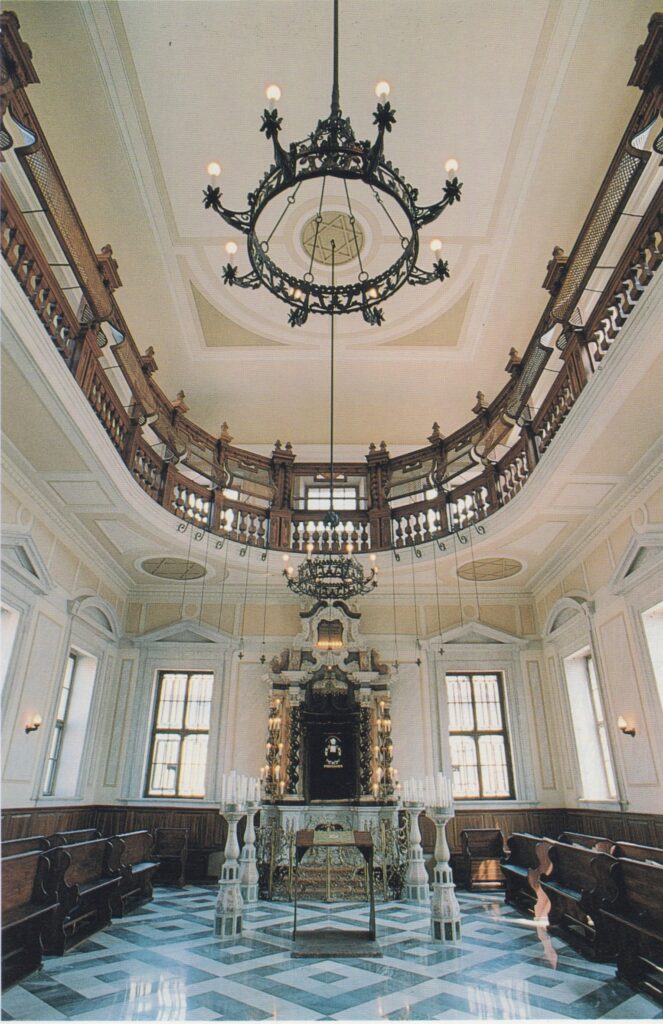Learn More

The Synagogue of Gorizia was inaugurated in 1756, on the site of a pre-existing oratory dating back to 1699. It was a Jewish religious building built before the Emancipation, and therefore without distinguishing features on the exterior, and located within the ghetto (as was sanctioned in the Papal Bull of 1555). It was possible to access the building from two passageways alongside the houses. From the outside, five windows were visible, reminiscent of the Pentateuch, which allowed Jews who were not local to Gorizia to recognise the School. Here the Jewish Community followed the Ashkenazi rite – a tradition deriving from German-speaking countries. The building is austere, elegant and sombre, with neoclassical decorations. Inside there is a bifocal orientation (the Aron is on the eastern side, in a Baroque, Venetian style; the Bimah is on the opposite side and made of cedar wood).
The Synagogue of Gorizia was severely damaged during the First World War, although fortunately the furnishings and sacred scrolls had been safely transferred to Trieste. In 1920, the Synagogue was refurbished and reopened. After 1936 the Community was no longer able to support a rabbi, and therefore relied on cantors and deputy rabbis.
Following the Armistice of 1943, Gorizia became part of the OZAK, which was directly administrated by the Nazis. On 23 November 1943 all of the thirty or so Jews remaining in the city were made to climb onto a lorry. They were taken from the Gorizia prison to that of Trieste, and from there they were deported to Auschwitz on the convoy of 7 December 1943. Of this group, only Giacomo Jacoboni returned. In the months following deportation, other Gorizian Jews from other areas in Northern Italy were deported, but only one returned: Iris Steinmann, who was captured in Modenese and deported from Fossoli. By summer 1944 there we no Jews left in Gorizia. Only their goods and their properties remained, all of which were gradually seized. The Synagogue was desecrated by the Nazis, who stole its silver and sacred decorations, after the caretaker told them where they were hidden.
After the War, the Jewish soldiers of the American infantry who were temporarily stationed in Gorizia sought to regrow the Jewish Community, even reopening the Synagogue thanks to the military rabbi Nathan A. Barack. When the soldiers left in 1947, the Jewish Community once again fell into crisis, and was unable to support itself. The Cemetery of Rožna Dolina / Valdirose was no longer used, since it was by this time outside Italian territory.
On 13 May 1951, the plaque commemorating the local Jews who had been deported was discovered, placed on the wall of the Synagogue’s internal courtyard.
In 1972 the Synagogue, which was by this time unused, fell into ruin and the Torah scrolls were deconsecrated. After being restored by the Commune of Gorizia, in 1984 it was inaugurated and reopened for worship, with an exhibition on Gorizian Judaism, called “Jerusalem on the Isonzo”.
The garden next to the Synagogue was named after the youngest Gorizian deportee, Bruno Farber, who was arrested along with his parents in Ferrara, where they had sought refuge. He was just a few months old.
SOURCES:
Orietta Altieri, La comunità ebraica di Gorizia: caratteristiche demografiche, economiche e sociali (1778-1900), Del Bianco, Udine 1985
Giuseppe Bolaffio, Sfogliando l’archivio della Comunità di Gorizia, in “La Rassegna Mensile Di Israel”, vol. 23, no. 12, 1957
Chiara Lesizza Budin, Vita e cultura ebraica nella Gorizia del Settecento, Edizioni della Laguna, Mariano del Friuli 1995
Adonella Cedarmas, La Comunità israelitica di Gorizia. 1900-1945, Istituto Friulano per la Storia del Movimento di Liberazione, Udine 1999
Miriam Davide and Pietro Ioly Zorattini (eds), Gli ebrei nella storia del Friuli Venezia Giulia. Una vicenda di lunga durata, Giuntina, Florence 2016
Pier Cesare Ioly Zorattini (ed.), Gli ebrei a Gorizia e a Trieste tra “ancien régime” ed emancipazione, Del Bianco, Udine 1984
Marcello Morpurgo, Valdirose. Memorie della Comunità ebraica di Gorizia, Del Bianco, Udine 1986
Translation from Italian to English by Bethany Gaunt
Project by
Jewish Community of Trieste and Ca’ Foscari University Venezia
Info
visit@triestebraica.it
